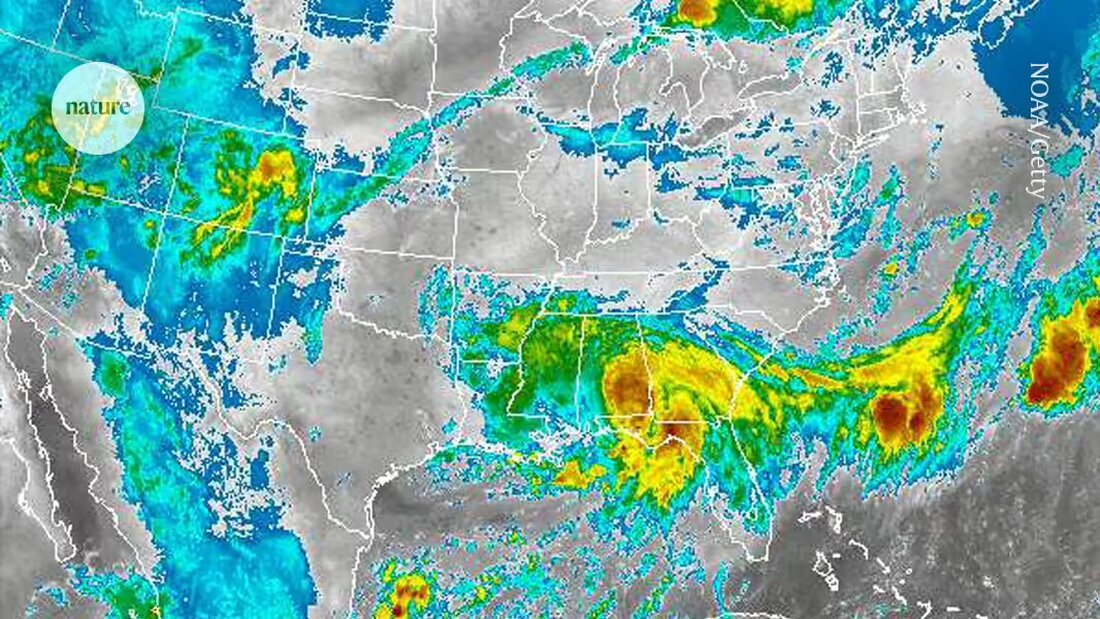Google AI forecast long -term climate trends and weather - in a few minutes
Google AI forecast long -term climate trends and weather - in a few minutes
A computer model that combines conventional weather forecast technology with machine learning has other artificial intelligence (KI)-based tools at Prediction of weather scenarios and long-term climate trends exceed.
The tool, which was described on July 22nd in Nature
“Traditional climate models must be carried out on supercomputers. This is a model that you can carry out in minutes,” says study mitar Stephan Hoyer, who studies at Google Research in Mountain View, California, Deep Learning.
Current predictive systems typically rely on general circulation models (GCMS), programs that rely on the laws of physics to simulate processes in the oceans and atmosphere of the earth and predict how they could influence the weather and the climate. However, GCMS require a lot of computing power, and progress in machine learning offers a more efficient alternative. "We have terabyte or petabyte (one million times larger than a gigabyte) of historical weather data," says Hoyer. “By learning from these patterns, we can build better models.”
There are already some machine learning models such as Pangu-Weather, which was created by the technology conglomerate Huawei, based in Shenzhen, China, and Graphcast by Deepmind with headquarters in London. These models have similar levels of accuracy as typical GCMS for deterministic predictions - an approach that generates a single weather forecast. However, GCMS are not so reliable for ensemble forecasts or long -term climate forecasts.
“The problem with pure mechanical learning approaches is that you only train it on data it has already seen," says Scott Hosking, who operates research on AI and environmental data at Institutes in London. "The climate changes continuously, we go into the unknown, so our machine learning models have to extrapolate into this unknown future. By integrating physics into the model, we can make sure that our models are physically limited and cannot do anything unrealistic."
hybrid model
Hoyer and his team developed and schooled neuralgcm, a model that combines “aspects of a traditional physics-based atmospheric loan procedure with some AI components,” says Hoyer. They used the model to create short and long-term weather forecasts and climate projections. In order to evaluate the accuracy of NeuralGCM, the researchers compared its predictions with real world data as well as the expenditure of other models, including GCMS and those that are based on machine learning.
Like current machine learning models, NeuralGCM was able to produce precise short -term, deterministic weather forecasts - between one and three days in advance - consuming a fraction of the energy required for GCMS. When producing long -term forecasts over seven days, however, it made much fewer mistakes than other mechanical learning models. In fact, the long-term forecasts of NeuralGCM were similar to the predictions of the ensemble model of the European Center for Medium-Range Weather Forecast (ECMWF-EN), a GCM that is widely considered a gold standard for weather forecasts.
The team also tested how well the model could predict different weather phenomena, such as tropical cyclones. They found that many of the pure machine learning models delivered inconsistent and inaccurate predictions compared to both neuralgcm and ECMWF-EN. The researchers even compared neuralgcm with high -resolution climate models, which are known as global storm -resolution models. NeuralGCM was able to produce more realistic tropical cyclone numbers and trajectories in a shorter time.
The ability to predict such events is “so important to improve decision skills and preparatory strategies,” says Hosking.
Hoyer and his colleagues want to further refine and adapt. "We have worked on the atmospheric part of modeling the earth system ... It is perhaps the part that has the most direct effect on the everyday weather," says Hoyer. He adds that the team wants to integrate more aspects of the earth sciences in future versions to further improve the accuracy of the model.
-
Kochkov, D. et al. Nature


Kommentare (0)